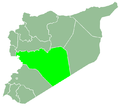Prior to 7th century
| History of Syria |
|---|
 |
| Timeline |
- 3rd millennium BCE – Citadel of Homs was founded. Biblical scholars have identified the city with Hamath-zobah. [1] [2]
- 732 BCE – Syro-Ephraimite War, Assyrians in power.
- 540 BCE – Persian Achaemenid Empire in power (approximate date).
- 64 BCE – The Arab Emesani dynasty were confirmed in their rule as client kings of the Romans.
- 50 AD – Saint Mary Church of the Holy Belt was consecrated.
- 432 AD – Church of Saint Elian was consecrated.


